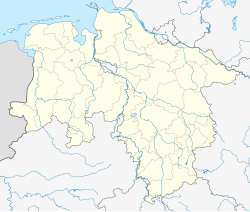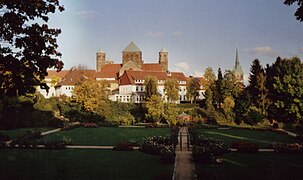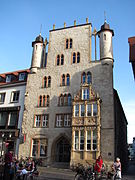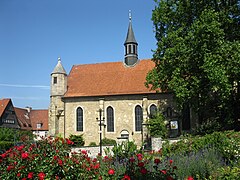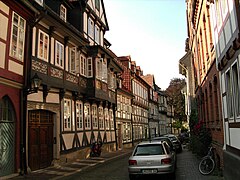Hildesheim
Hildesheim
| |
|---|---|
|
Clockwise from top: St. Mary's Cathedral (UNESCO World Heritage Site), half-timbered houses at the Brühl street, St. Andrews Church, St. Michael's Church (UNESCO World Heritage Site), Roemer- und Pelizaeus-Museum and the Historic Market Place | |
Location of Hildesheim within Hildesheim district <imagemap>File: Hildesheim in HI.svg | 240x240px rect 195 164 242 211 Hildesheim (district) rect 14 8 313 292 Lower Saxony poly 2 1036 77 1131 160 1181 216 1171 249 1122 302 1112 346 1117 345 1150 378 1181 430 1187 441 1239 483 1274 532 1280 563 1312 591 1338 463 1389 3 1384 Holzminden (district) poly 481 1387 615 1336 654 1316 680 1352 719 1329 780 1373 883 1309 835 1234 915 1206 977 1257 973 1276 1033 1338 1016 1389 Northeim (district) poly 1389 973 1315 1020 1254 1013 1282 1135 1241 1178 1023 1157 1006 1287 1055 1344 1038 1384 1389 1378 Goslar (district) poly 1313 424 1316 451 1305 453 1316 495 1351 543 1320 586 1357 660 1388 670 1388 974 1313 1019 1292 998 1256 1005 1272 980 1261 899 1246 871 1272 851 1252 818 1278 804 1251 730 1216 718 1217 653 1264 613 1229 546 1226 482 1261 429 Wolfenbüttel (district) poly 1392 438 1340 432 1317 449 1310 494 1339 528 1332 617 1359 630 1373 646 1381 648 1389 660 Salzgitter poly 74 1120 85 1109 54 1073 80 1025 71 954 102 925 82 904 84 860 66 850 101 747 156 690 87 657 67 634 61 600 40 604 25 591 6 566 2 1028 Hamelin-Pyrmont poly 1 560 2 297 316 290 317 9 979 0 890 47 891 77 849 86 814 75 843 28 825 32 812 49 761 40 760 72 629 89 635 129 562 147 554 103 447 139 377 188 378 217 344 228 345 245 332 250 335 260 369 254 370 274 384 280 433 266 432 311 410 321 401 397 393 374 358 389 347 442 324 448 271 360 176 365 154 398 239 465 174 545 176 575 73 583 Hanover (district) poly 996 4 1379 4 1388 430 1373 428 1370 394 1382 385 1345 293 1294 264 1230 232 1165 221 1163 260 1145 249 1128 219 975 243 968 264 955 271 905 233 853 245 831 243 835 176 890 149 898 47 Peine (district) poly 513 1254 524 1236 534 1243 542 1205 536 1197 522 1170 538 1176 539 1170 560 1150 571 1158 584 1143 587 1135 597 1127 600 1139 615 1151 629 1155 641 1145 653 1147 656 1153 665 1157 672 1169 709 1159 711 1152 729 1143 748 1141 752 1147 740 1158 717 1156 718 1164 726 1164 729 1181 735 1187 744 1174 777 1180 794 1211 802 1220 805 1234 819 1241 830 1243 835 1261 846 1267 850 1291 859 1288 864 1310 854 1324 841 1321 831 1333 804 1342 805 1350 791 1350 772 1363 756 1347 749 1334 732 1326 718 1309 701 1333 680 1340 662 1322 660 1306 645 1313 615 1335 584 1304 579 1308 563 1305 561 1296 549 1297 536 1289 516 1266 Freden poly 614 1144 625 1133 645 1091 646 1083 658 1080 665 1064 686 1059 703 1058 706 1048 718 1040 738 1032 743 1016 739 1006 737 966 757 955 763 944 778 936 791 947 801 942 816 957 823 974 853 968 864 975 871 996 878 996 878 1006 874 1006 874 1024 881 1017 888 1017 894 1032 904 1040 903 1047 914 1062 951 1078 959 1076 963 1083 987 1089 988 1095 1002 1095 1017 1105 1001 1113 1003 1120 1015 1126 1013 1151 1007 1158 1006 1168 990 1185 996 1194 986 1215 1004 1230 988 1245 994 1250 976 1256 958 1237 948 1234 934 1212 904 1191 901 1203 886 1219 879 1215 873 1225 862 1214 853 1212 850 1218 841 1217 837 1223 819 1223 826 1230 822 1237 808 1235 806 1221 790 1201 778 1177 760 1180 748 1178 737 1190 734 1182 728 1165 720 1164 719 1159 742 1159 754 1146 750 1140 731 1145 714 1152 707 1158 692 1164 676 1166 669 1156 658 1153 656 1147 635 1144 636 1149 628 1156 621 1151 Lamspringe poly 861 969 923 923 909 877 969 841 960 818 979 817 985 849 1026 833 1049 811 1091 845 1109 814 1135 824 1215 872 1239 857 1257 916 1260 995 1247 1005 1252 1102 1275 1131 1240 1164 1113 1159 1114 1136 1091 1157 1012 1139 1016 1096 907 1055 887 1018 Bockenem poly 281 1015 349 984 308 914 329 900 371 952 432 947 445 958 491 934 554 990 589 963 609 968 565 1005 565 1022 624 1018 612 1038 624 1075 605 1121 582 1152 557 1154 533 1169 520 1172 536 1234 513 1245 502 1254 466 1252 449 1227 452 1199 388 1154 377 1164 356 1150 362 1128 330 1076 299 1085 284 1027 Alfeld poly 173 1175 143 1158 133 1139 118 1132 94 1142 88 1129 91 1122 60 1075 76 1055 76 1043 80 1034 89 1038 92 1025 101 1029 95 1019 80 1015 79 966 93 962 100 942 115 918 106 921 123 873 131 848 158 871 171 876 175 871 185 876 193 885 194 897 210 893 215 915 223 916 228 896 233 889 247 883 244 880 253 874 225 833 226 825 232 820 235 826 240 826 246 837 247 845 272 875 309 921 330 962 337 969 348 984 338 992 327 997 322 992 308 996 297 1000 298 1005 279 1024 289 1035 287 1040 301 1062 288 1064 295 1081 304 1087 292 1096 266 1096 243 1093 241 1087 229 1082 223 1095 220 1119 222 1129 214 1139 194 1145 185 1150 Duingen poly 327 250 375 217 385 189 549 128 555 159 634 135 649 177 667 165 677 213 673 243 643 232 623 250 517 254 532 342 516 369 497 370 496 356 456 335 458 314 436 313 433 265 405 260 394 239 Sarstedt poly 634 84 647 169 669 169 684 189 684 234 747 241 821 257 815 161 885 137 892 71 829 91 811 75 829 36 798 53 762 50 743 78 Algermissen poly 656 233 657 326 694 329 736 416 803 388 801 412 857 431 938 413 948 360 1000 356 997 310 976 262 949 281 909 241 789 261 744 238 Harsum poly 502 376 513 487 597 495 596 411 662 424 666 386 710 382 694 323 652 331 644 239 523 255 531 342 Giesen poly 155 392 245 462 323 474 285 561 330 633 473 572 507 602 526 546 514 536 535 495 517 476 495 356 435 315 404 394 358 394 366 439 326 465 258 365 194 365 Nordstemmen poly 538 492 502 608 561 675 642 710 720 620 743 624 831 681 859 590 904 593 913 560 884 540 897 480 855 429 809 406 798 371 773 381 773 401 725 414 714 385 647 394 654 422 596 416 603 488 Hildesheim poly 163 679 92 786 106 799 179 802 228 711 331 642 289 555 317 475 283 482 244 458 173 556 174 575 140 597 37 592 55 610 84 653 157 675 Elze poly 278 682 262 731 273 737 265 748 282 759 277 772 280 777 280 784 269 777 267 783 274 788 267 817 259 818 260 842 254 848 280 886 308 920 320 910 330 907 336 925 345 932 356 932 365 938 355 941 372 959 388 958 403 952 403 947 410 945 418 956 429 947 438 959 459 958 464 942 492 934 502 936 497 925 470 915 470 905 454 885 454 876 448 861 465 850 478 842 484 828 494 828 495 815 502 804 519 797 523 806 534 801 536 809 530 809 530 819 544 819 546 801 537 791 542 783 572 748 580 748 590 744 555 716 541 697 562 674 532 638 523 620 507 613 492 589 484 586 476 577 466 577 428 595 420 589 387 601 370 602 371 611 358 607 341 612 342 621 333 631 322 620 318 629 319 641 324 647 284 672 284 680 Gronau poly 89 902 103 914 129 850 217 913 258 874 216 817 235 820 253 848 282 770 264 732 282 677 225 710 176 799 98 808 74 849 89 856 Eime poly 499 717 521 704 525 714 512 725 500 723 Diekholzen poly 560 681 551 706 671 807 714 780 803 774 841 677 738 623 716 627 661 677 642 712 Diekholzen poly 1159 527 1169 530 1160 582 1148 583 1161 530 Schellerten poly 898 590 971 609 983 643 1000 651 1020 606 1051 592 1047 614 1078 631 1139 644 1124 499 1113 478 1119 442 1153 423 1142 393 1116 385 1141 263 1123 240 990 270 1004 316 998 361 950 360 944 422 861 433 902 472 Schellerten poly 1133 624 1227 580 1223 559 1194 551 1250 433 1285 415 1314 422 1314 447 1376 431 1365 396 1380 382 1347 330 1345 302 1204 236 1150 264 1141 265 1110 347 1119 380 1142 391 1153 427 1115 460 1113 498 1131 510 Söhlde poly 740 770 740 793 754 804 751 841 780 940 859 970 931 928 912 871 985 842 971 820 983 802 1003 711 996 686 984 647 972 608 856 588 807 772 Bad Salzdetfurth poly 990 649 1005 721 981 821 987 849 1035 832 1056 820 1106 844 1112 814 1141 821 1180 866 1213 873 1247 859 1243 811 1256 797 1249 734 1206 732 1198 641 1241 608 1231 561 1225 562 1219 578 1167 584 1151 613 1139 630 1128 649 1075 636 1030 603 Holle poly 591 743 576 748 541 783 538 792 547 800 545 818 531 819 530 811 536 811 535 801 523 799 509 801 498 812 494 826 486 827 481 840 448 861 457 885 469 901 468 914 497 924 502 939 509 948 529 955 525 966 534 970 548 982 554 995 567 983 577 968 592 965 597 972 585 979 569 998 566 1020 573 1023 580 1015 601 1011 613 1020 620 1013 632 1009 634 1016 625 1026 616 1031 621 1048 619 1056 632 1066 616 1123 608 1123 605 1126 611 1132 598 1135 612 1146 623 1132 643 1092 645 1081 658 1080 664 1065 686 1059 706 1056 708 1048 725 1039 738 1031 741 1018 737 1005 741 1001 735 965 755 956 769 942 780 932 777 914 766 882 766 867 756 865 760 852 748 847 741 837 752 818 757 804 738 793 742 780 741 771 735 773 733 779 710 779 691 793 682 799 682 809 665 802 643 775 613 758 607 749 Sibbesse desc bottom-right </imagemap> | |
| Coordinates: 52°09′N 09°57′E / 52.150°N 9.950°E | |
| Country | Germany |
| State | Lower Saxony |
| District | Hildesheim |
| Government | |
| • Lord mayor (2021–26) | Ingo Meyer[1] (Ind.) |
| Area | |
| • Total | 92.18 km2 (35.59 sq mi) |
| Elevation | 81 m (266 ft) |
| Population (2022-12-31)[2] | |
| • Total | 101,858 |
| • Density | 1,100/km2 (2,900/sq mi) |
| Time zone | UTC+01:00 (CET) |
| • Summer (DST) | UTC+02:00 (CEST) |
| Postal codes | 31134–31141 |
| Dialling codes | 05121 |
| Vehicle registration | HI, ALF |
| Website | www.hildesheim.de |
| UNESCO World Heritage Site | |
|---|---|
 Ottonian architecture in St. Michael's Church | |
| Criteria | Cultural: i, ii, iii |
| Reference | 187 |
| Inscription | 1987 (11th Session) |
| Area | 0.58 ha |
| Buffer zone | 157.68 ha |
Hildesheim (German: [ˈhɪldəsˌhaɪm] ; Low German: Hilmessen or Hilmssen; Latin: Hildesia) is a city in Lower Saxony, in north-central Germany with 101,693 inhabitants.[3] It is in the district of Hildesheim, about 30 km (19 mi) southeast of Hanover on the banks of the Innerste River, a small tributary of the Leine River.
The Holy Roman Emperor Louis the Pious founded the Bishopric of Hildesheim in 815 and created the first settlement with a chapel on the so-called Domhügel.
Hildesheim is situated on the north–south Autobahn 7, and hence is connected with Hamburg in the north and Austria in the south.
With the Hildesheim Cathedral and the St. Michael's Church, Hildesheim became a UNESCO World Heritage Site in 1985.
In 2015 the city and the diocese celebrated their 1200th anniversary.
History
Early years
According to tradition, the city was named after its founder Hildwin.[4] The city is one of the oldest cities in Northern Germany, became the seat of the Bishopric of Hildesheim in 815 and may have been founded when the bishop moved from Elze to the ford across the River Innerste, which was an important market on the Hellweg trade route. The settlement around the cathedral very quickly developed into a town and was granted market rights by King Otto III in 983.[5] Originally the market was held in a street called Alter Markt (Old Market) which still exists today. The first marketplace was laid out around the church St. Andreas. When the city grew further, a larger market place became necessary. The present market place of Hildesheim was laid out at the beginning of the 13th century when the city had about 5,000 inhabitants.
Middle Ages
When Hildesheim obtained city status in 1249, it was one of the biggest cities in Northern Germany.[6] For four centuries the clergy ruled Hildesheim, before a town Hall was built and the citizens gained some influence and independence. Construction of the present Town Hall started in 1268.[7] In 1367 Hildesheim became a member of the Hanseatic League. A war between the citizens and their bishop cost dearly in 1519–23 when they engaged in a feud.
Reformation to 17th century
Hildesheim became Lutheran in 1542, and only the cathedral and a few other buildings remained in Imperial (Roman Catholic) hands. Several villages around the city remained Roman Catholic as well.
During the Thirty Years' War, Hildesheim was besieged and occupied several times: in 1628 and 1632 by imperial troops; and in 1634 by troops from Brunswick and Lüneburg.[8]
19th century
In 1813, after the Napoleonic Wars, the town became part of the Kingdom of Hanover, which was annexed by the Kingdom of Prussia as a province after the Austro-Prussian War in 1866. In 1868 a highly valuable trove of about 70 Roman silver vessels for eating and drinking, the so-called Hildesheim Treasure, was unearthed by Prussian soldiers.
Early 20th century and World War II

Early in World War II, Nazi roundups of the Jewish population began, and hundreds of Hildesheim's Jews were sent to concentration camps. Hildesheim was the location of a forced labour subcamp of the Nazi prison in Celle, and a subcamp of the Neuengamme concentration camp.[9][10] After the dissolution of the latter, the surviving prisoners were sent on a death march to Ahlem.[10] The city was heavily damaged by British air raids in 1945, especially on 22 March. Although Hildesheim had little military significance, two months before the end of the war the historic city was bombed as part of Britain′s Area Bombing Directive in order to undermine German civilian morale. As a result, 29% of the houses were destroyed and 45% damaged, while only 26% of the houses remained undamaged. The centre, which had retained its medieval character until then, was almost leveled. Destruction in the city as a whole was estimated at 20 to 30 percent.[11] Around 200 out of 800 half timer framed houses survived.[12]
During the war, valuable world heritage materials had been hidden in underground cellars. After the war and its aftermath, priority was given to rapid building of housing, and concrete structures took the place of the wrecked historic buildings. Most of the major churches – two of them now UNESCO World Heritage sites – were rebuilt in the original style soon after the war.
Late 20th century and present
In 1978, the University of Hildesheim was founded. In the 1980s a reconstruction of the historic centre began. Some of the unattractive concrete buildings around the market place were torn down and replaced by replicas of the original buildings. In the autumn of 2007, a decision was made to reconstruct the Umgestülpter Zuckerhut (Upended Sugarloaf), an iconic half-timbered house famous for its unusual shape. In 2015 the city and the diocese celebrates their 1200 anniversary with the Day of Lower Saxony.
Religions
In 1542 most of the inhabitants became Lutherans. Today, 28.5% of the inhabitants identify themselves as Roman Catholics (Hildesheim Diocese) and 38.3% as Protestants (Evangelical Lutheran Church of Hanover). 33.0% of the inhabitants are adherents of other religions or do not have a religion at all. Up until 2015 the Serbian Orthodox Bishop of Germany had his seat in Himmelsthür (a locality of Hildesheim), before the seat moved to Frankfurt and, in 2018, to Düsseldorf.
Main sights

- The Marktplatz (historic market place) was reconstructed in 1984–1990 after its destruction in the March 1945 air raid. The more noteworthy buildings in the square are:
- The Knochenhaueramtshaus (Butchers' Guild Hall), originally built in 1529 and destroyed in 1945, it was reconstructed from 1987 to 1989 according to original plans. The façade is sumptuously decorated with colourful paintings and German proverbs. Today the building houses a restaurant and the City Museum.
- The Bäckeramtshaus (Bakers' Guild Hall) is a half-timbered house which was originally built in 1825. It was destroyed in 1945 and rebuilt 1987-89. Today, it houses a café.
- The Town Hall, erected in the 13th century in Gothic style. Partly destroyed in 1945, it was rebuilt and inaugurated in 1954.
- The Tempelhaus, a late-Gothic 14th-century patrician house, which today houses the tourist information office. It suffered some damage during the Second World War but was restored by 1950.
- The Wedekindhaus, a 16th-century patrician house, is characterised by its high, ornately carved storeys including their ledges with depictions of allegorical figures.
- The adjoining Lüntzelhaus was built in 1755 in Baroque style.
- The Rolandhaus was originally built in the 14th century in Gothic style. In 1730, the house was remodelled, and a Baroque portal and a large bay window were added.
- The Stadtschänke (Town Tavern) is a large half-timbered house which was originally built in 1666. The smaller adjoining Rococcohaus was built in 1730 in rococo style.
- The Wollenwebergildehaus (Weavers' Guild Hall) was approximately built in 1600.
- The Romanesque St. Mary's Cathedral (Hildesheim Cathedral), with its ancient bronze doors (Bernward Doors) (c. 1015) and other treasures. The cathedral was built in the 9th century, but almost completely destroyed in 1945; it was reconstructed soon after the war. It has been listed as a UNESCO World Heritage Site since 1985. The "Thousand-year Rose" is a reputedly 1,000‑year‑old dog rose bush, allegedly the world's oldest living rose. It continues to flourish on the wall of the cathedral apse.
- Museum of the Cathedral: Cathedral Treasure.
- St. Michael's Church (UNESCO World Heritage Site) – an early Romanesque church in Germany and an example of Ottonian architecture. It was built from 1010 to 1022.
- The St. Andreas (St. Andrew's Church), a 12th-century Gothic church with the highest church steeple (114.5 m) in Lower Saxony. Opposite the church stands the Upended Sugarloaf, a half-timbered house dating from 1509.
- The Roemer-und-Pelizaeus-Museum, with collections from ancient Egypt and Peru and special exhibitions.
- The Kreuzkirche (Church of the Holy Cross) was originally a part of the medieval fortifications. It was converted into a church around 1079, severely damaged in 1945 and rebuilt after the war.
- The Romanesque Basilica Minor of St. Godehard (St. Gotthard's Church), built 1133–1172, which is scheduled to become a UNESCO World Heritage Site in the near future. Other notable buildings stand opposite the church: St. Nicolai's Chapel is a former parish church which was built in the Romanesque style in the 12th century and transformed into a residential building after 1803, and the Hospital of the Five Wounds which is a large half-timbered house dating from 1770 with a half-hip roof.
- The church St. Lamberti is a late Gothic building, venue of a weekly concert series at market time.
- The Kehrwiederturm (Kehrwieder Tower), built around 1300, is the only remaining tower of the medieval fortifications.
- Half-timbered houses which were not destroyed during World War II can be seen around St. Godehard and the Kehrwieder Tower, in the streets Keßlerstraße, Knollenstraße, Gelber Stern, Am Kehrwieder, Lappenberg, Brühl, Hinterer Brühl, and Godehardsplatz. Some of them have ornate wood carvings in their façades, e.g. the Wernersches Haus (1606) in Godehardsplatz and the Waffenschmiedehaus (weapon smith house, 1548) at Gelber Stern.
- The church St. Jacobi (St. James' Church) is a 500-year-old pilgrim church in the Gothic style and was one of the many St. James chapels on St. James's Path. Today the church is a culture church with emphasis on literature.
- The Monument of the Synagogue (consecrated in 1849 and destroyed in 1938 during the Kristallnacht) was erected in 1988 in the old Jewish quarter on Lappenberg Street. The foundations were reconstructed to give observers an idea of how large the synagogue was. The reddish brick building (built around 1840) opposite was the Jewish school.
- Mauritiuskirche (St. Maurice's Church), a Romanesque church (11th century) on a hill in the west of the city in the quarter of Moritzberg with a cloister. The interior of the church is Baroque and the tower was added in 1765.
- Kaiserhaus (Emperor's House): Renaissance building (1586) in Alter Markt, the oldest street of Hildesheim, rebuilt after the war. The façade is decorated with Roman statues and medallions. Opposite, there is a noteworthy sandstone bay window dating from 1568. Originally, it belonged to a private house which was torn down at the end of the 19th century. The bay window was dismantled before and added to another house in the eastern part of Hildesheim which remained undamaged during World War II. From there, the bay window was removed when the house was remodelled and added to the school at the present site in 1972.[13]
- Close to the Kaiserhaus (Emperor's house) the Alte Kemenate, a noteworthy medieval store house reaching a height of 5.5 meters, can be seen behind the school in the street Alter Markt. It has a rectangular basis measuring 6.5 meters × 5.0 meters and a cellar with a vaulted construction.[14] The store house, one of the oldest profane buildings in Hildesheim, was built of sandstone in a Gothic style the 15th century. According to other sources it might be even older, i.e. built between the end of the 11th and the middle of the 13th century.[15] The building has two floors. As it did not consist of wood it did not burn down in 1945, but was only damaged and immediately repaired after the war. From 1945 - 1951 it was used for residential purposes. The Alte Kemenate is not open to the public.
- St Magdalena's Church (Magdalenenkirche) is a small church with large lancet windows in the historic street Old Market (Alter Markt) which was consecrated in 1224. It was originally built in a Romanesque style, but enlarged and remodelled in Gothic style in 1456. It houses a wooden altar (about 1520) with carvings and other works of art. The small street Süsternstraße features a well-preserved part of the medieval city wall with a round tower. Opposite the church, a tall half-timbered house which was rebuilt in 1981 on the medieval city wall can be seen in the small side street Mühlenstraße. The façade is decorated with wood carvings.
- Magdalenengarten, a Baroque park which was laid out in 1720–1725, is near St. Magdalena's Church. There are many different kinds of rose bush, a rose museum, pavilions, Baroque statues, a well-preserved part of the medieval city wall in it and even a vineyard yielding 100–200 bottles of wine per year. In spring a rare species of wild yellow tulip (tulipa sylvestris) blossoms in the western part of the park.
- St. Bernward's Church, a neo-Romanesque church built 1905–1907, destroyed in 1945 and rebuilt from 1948 to 1949, houses a Gothic wooden altar retable dating from the beginning of the 15th century.
- A part of the medieval defence system consisting of a wall with moats and ramparts, built around the city in the 13th century, is well preserved. Kalenberger Graben, an artificial lake, is a part of it. It is surrounded by a park. In April a rare species of wild yellow tulip (tulipa sylvestris) blossoms in the park.
- Steuerwald Castle (Burg Steuerwald) in the north of the city, about 3 km (2 mi) from the Market Place, was built 1310–13. Its tower (25 m) was added in 1325. The chapel, dedicated to St Magdalena, was originally built in the Romanesque style and transformed into a Gothic chapel in 1507. Today it is used for weddings and concerts.
- Marienburg Castle (Burg Marienburg) is in the southeast of Hildesheim, about 6 km (4 mi) from the Market Place. It was built 1346–1349.
- Sorsum is a former village in the West of Hildesheim which became a part of the city in 1974. There is a former domain, founded in the Middle Ages, which was transformed into a residential area after 2000. The pigeon tower, built in 1733, the large barn (1786) and the manor house dating from 1734 are the most notable sights in this rural part of Hildesheim.
- Marienrode Priory (Kloster Marienrode) is in the southwest of Hildesheim, about 6 km (4 mi) from the Market Place. It was founded in 1125. The foundation stone of the present church was laid in 1412. The church was built in Gothic style with three naves and completed in 1462. The Baroque ridge turret was added in the 18th century. In the church, there are two noteworthy Baroque altars dating from 1750 approximately and a Gothic sandstone sculpture of Saint Mary which was made in 1460. The organ dates from the middle of the 18th century. A small chapel of the priory, Saint Cosmas and Damian, which was built in 1792, was converted into a small Protestant church in 1830. The priory was dissolved in 1806, but returned to the Catholic Church in 1986. Since 1988, it has again been operated by nuns. Near the monastery there is a large fishpond with a tall windmill built in 1839.
Other places of interest include the theatre, offering opera, operetta and musicals, drama, ballet and concerts.
-
St. Michael's Church, UNESCO World Heritage
-
Bakers' Guild Hall and Butchers' Guild Hall in the Market Place
-
Historic Market Place with City Hall and market fountain
-
Saint Michael's Church and the tower of St. Andreas seen from St. Magdalena's Garden
-
Tempelhaus in the historic Market Place
-
The Wernersches House (1606) is a half-timbered house with wood carvings in its façade.
-
Half-timbered houses in Lappenberg Street
-
Tower Kehrwiederturm (14th century)
-
Renaissance bay window in Alter Markt Street
-
River Innerste and Saint Magdalena's Church
-
Baroque park Magdalenengarten
-
Vineyard in Magdalenengarten
-
Alte Kemenate, a medieval store house (15th century)
-
St. Magdalena's Church
-
Half-timbered house (1981) built on the medieval city wall in Mühlenstraße
Incorporations
- 1911: Moritzberg
- 1912: Steuerwald
- 1938: Drispenstedt and Neuhof
- 1971: Ochtersum
- 1974: Achtum-Uppen, Bavenstedt, Einum, Himmelsthür, Itzum, Marienburg, Marienrode and Sorsum
Demographics
Population history
On 31 Dec 2017 Hildesheim had 103,970 inhabitants.[16]
| Year | Pop. | ±% |
|---|---|---|
| 1400 | 6,000 | — |
| 1450 | 8,000 | +33.3% |
| 1648 | 5,500 | −31.2% |
| 1803 | 11,108 | +102.0% |
| 1825 | 12,630 | +13.7% |
| 1849 | 14,651 | +16.0% |
| 1871 | 20,801 | +42.0% |
| 1875 | 22,581 | +8.6% |
| 1890 | 33,481 | +48.3% |
| 1900 | 42,973 | +28.4% |
| 1910 | 50,239 | +16.9% |
| 1919 | 53,499 | +6.5% |
| 1925 | 58,522 | +9.4% |
| 1933 | 62,519 | +6.8% |
| 1939 | 72,101 | +15.3% |
| 1950 | 65,531 | −9.1% |
| 1961 | 96,296 | +46.9% |
| 1970 | 93,400 | −3.0% |
| 1975 | 106,000 | +13.5% |
| 1980 | 102,700 | −3.1% |
| 1985 | 100,900 | −1.8% |
| 1989 | 103,512 | +2.6% |
| 1997 | 105,700 | +2.1% |
| 2002 | 103,448 | −2.1% |
| 2013 | 100,708 | −2.6% |
| 2015 | 101,667 | +1.0% |
| 2017 | 103,970 | +2.3% |
| 2019 | 101,693 | −2.2% |
Largest minority groups
The following list shows the largest foreign groups in the city of Hildesheim as of 2013[update]:[17]
| Rank | Nationality | Population (2016) |
|---|---|---|
| 1 | 2,395 | |
| 2 | 764 | |
| 3 | 474 | |
| 4 | 442 | |
| 5 | 299 | |
| 6 | 268 | |
| 7 | 254 | |
| 8 | 243 |
List of mayors of Hildesheim
- 1803–1843: Georg Otto Ferdinand Lohde
- 1843–1848: Carl Christoph Lüntzel
- 1848: Commissioned by Oberg, Starke, and Wynecken
- 1848–1852: Amtsassessor Domeier
- 1853–1875: Paul Johann Friedrich Boysen
- 1876–1895: Gustav Struckmann
- 1895–1896: Hans Ukert, not as mayor
- 1896–1909: Gustav Struckmann, reelected
- 1909–1937: Ernst Ehrlicher
- 1945–1946: Erich Bruschke
- 1946–1950: Albin Hunger
- 1950–1952: Friedrich Lekve
- 1952–1958: Albin Hunger, reelected
- 1958–1959: Paul Lienke
- 1959–1964: Martin Boyken
- 1964–1968: Friedrich Nämsch
- 1968–1972: Martin Boyken, reelected
- 1972–1975: Friedrich Nämsch, reelected
- 1975–1981: Heiko Klinge
- 1981–1991: Gerold Klemke
- 1991–2001: Kurt Machens
- 2001–2005: Dr. Ulrich Kumme
- 2005–2014: Kurt Machens, reelected
- 2014–present: Dr. Ingo Meyer
Twin towns – sister cities
Hildesheim is twinned with:[18]
 Angoulême, France (1965)
Angoulême, France (1965) Minya, Egypt (1975)
Minya, Egypt (1975) Weston-super-Mare, England, United Kingdom (1983)
Weston-super-Mare, England, United Kingdom (1983) Gelendzhik, Russia (1992)
Gelendzhik, Russia (1992) North Somerset, England, United Kingdom (1997)
North Somerset, England, United Kingdom (1997) Pavia, Italy (2000)
Pavia, Italy (2000)
Events of international interest
- M'era Luna Festival, Europe's most important event of the gothic and wave scene
- "Jazztime" festival on the weekend of Pentecost (in May or June)
Economy
Important and significant companies in the city of Hildesheim are:
- Robert Bosch Car Multimedia
- St. Bernward Hospital
- Helios Hospital
- Sparkasse Hildesheim
- KSM Castings Group
- Petrofer Chemie H. R.
- Optimal Personal & Organisation
- Medifox DAN
- Howmet Aerospace
Transport
Hildesheim has an efficient traffic infrastructure: it is a regional hub for national roads and railway (Hildesheim Hauptbahnhof is served by InterCityExpress services), is connected to the motorway (Autobahn), has a harbour on the Mittellandkanal (canal) and Hildesheim Betriebsgesellschaft Airfield.
Education
There are many secondary schools (Gymnasiums, comprehensive schools and subject-specific secondary schools): Gymnasium Andreanum, Gymnasium Marienschule, Gymnasium Josephinum Hildesheim, Scharnhorstgymnasium Hildesheim, Goethegymnasium Hildesheim, Michelsenschule, Gymnasium Himmelsthür. Further: Freie Waldorfschule Hildesheim, Robert-Bosch-Gesamtschule. Friedrich-List-Schule (Fachgymnasium Wirtschaft), Herman-Nohl-Schule (Fachgymnasium Gesundheit und Soziales), Walter-Gropius-Schule (Berufsbildende Schule), Werner-von-Siemens-Schule (Fachgymnasium Technik), Elisabeth-von-Rantzau-Schule (Fachakademie für Sozialmanagement).
Tertiary Education can be achieved at the University of Hildesheim or Hochschule für angewandte Wissenschaft und Kunst (HAWK), a co-operation with the cities of Holzminden and Göttingen.
Culture
The community has the headquarters of the Serbian Orthodox Eparchy of Frankfurt and all of Germany.[19]
Notable people


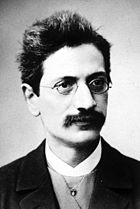

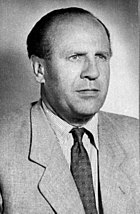
Public service & public thinking
- Gotthard of Hildesheim (960–1038), Roman Catholic saint
- Bernward of Hildesheim (960–1022), Bishop of Hildesheim
- Leo of Vercelli (ca 965–1026), prelate who served as the Bishop of Vercelli from 999
- Benno of Meissen (ca 1010–1106), named Bishop of Meissen in 1066, canonized in 1523.
- Adelog of Hildesheim (died 1190), Bishop of Hildesheim from 1171 to 1190
- John of Hildesheim (ca 1310–1375), Carmelite friar and writer
- Didrik Pining (1430–1491), explorer of the North Atlantic & privateer
- Eva von Trott (1505–1567), the royal mistress of Henry V, Duke of Brunswick-Lüneburg, from 1522 until 1567.
- Christoph Daniel Ebeling (1741–1817), scholar who studied the geography and history of North America.[20]
- Frederick Hornemann (1772–1801), German African explorer.[21]
- Philip Marheineke (1780–1846), Protestant church leader.[22]
- Christian August Brandis (1790–1867), philologist and historian of philosophy.[23]
- Moritz Güdemann (1835–1918), an Austrian rabbi, historian and Chief rabbi of Vienna.
- Henry Rathbone (1837–1911), US Consul, committed to an asylum for the criminally insane after murdering his wife
- Jakob Guttmann (1845–1919), chief rabbi locally, 1874 and 1892 and philosopher
- Adolf Bertram (1859–1945), German Roman Catholic bishop and cardinal
- Julius Guttmann (1880–1950), German and Israeli rabbi, Jewish philosopher and historian
- Wilhelm Koppe (1896–1975), Obergruppenführer and General der Waffen-SS und Polizei
- Harald Freiherr von Elverfeldt (1900–1945), a general in the Wehrmacht during World War II
- Karl Hamann (1903–1973), 1948–51 chairman of the LDPD and minister
- Wolfram Sievers (1905–1948), Nazi war criminal and director of Ahnenerbe, executed for war crimes
- Stefan Schostok (born 1964), politician, Mayor of Hanover from 2013 to 2019.
- Andreas Bovenschulte (born 1965), politician, mayor of Bremen since 2019
- Mauritius Wilde (born 1965), a Benedictine monk, priest, professor, podcaster, spiritual director and author.
- Hubertus Heil (born 1972), politician (SPD) & Govt. minister
- Prince Ernst August of Hanover (born 1983), hereditary Prince of Hannover
- Christian von Hanover (born 1985) a German prince in pretense
The Arts
- Wilhelm Schmidthild (1876–1951), painter, graphic artist, illustrator and art professor.
- Erich Pommer (1889–1966), film producer
- Eberhard Schlotter (1921–2014), painter and graphic artist
- Guy Stern (born 1922), American literary critic and honorary citizen of the city
- Lily Franz (1924–2011), a Sinti writer, lived locally
- Hans Raffert (1927–2005), chef, he was White House Executive Chef from 1988 to 1992.
- Rudolf Schenker (born 1948), guitarist and founding member of the hard rock band Scorpions
- Bernd Clüver (1948–2011), crooner, sang The boy with the harmonica
- Michael Schenker (born 1955), German rock guitarist, founding member of the Scorpions and of the band UFO
- Thomas Quasthoff (born 1959), German bass-baritone singer
- Twins Wolfgang and Christoph Lauenstein (born 1962), winners of an Academy Award in 1989 for their film Balance
- Petra Hartmann (born 1970), novelist, journalist and author.
- Diane Kruger (born 1976), supermodel and actress, who played Helen in the film Troy
Science & business
- Ludolph van Ceulen (1540–1610), a German-Dutch mathematicianl he emigrated to the Netherlands.
- Catharina Helena Dörrien (1717–1795), botanist
- Johann Heinrich Friedrich Link (1767–1851), naturalist and botanist.
- Friedrich Adolph Roemer (1809–1869), geologist.[24]
- Ferdinand von Roemer (1818–1891), geologist.[25]
- Adolf Hurwitz (1859–1919), mathematician, worked on algebra, analysis, geometry and number theory.
- Heinrich Nordhoff (1899–1968), engineer, Chairman of Volkswagen and key figure in the VW Beetle's history
- Sir Hans Adolf Krebs FRS (1900–1981), physician and biochemist, Physiology and Medicine in 1953
- Oskar Schindler (1908–1974), German industrialist, died in Hildesheim, Righteous Among the Nations, about whom the book Schindler's Ark was written; see also the film Schindler's List
- Fuad El-Hibri (1958–2022), a German-American businessman and philanthropist, founded Emergent BioSolutions
Sport
- Wolfgang Danne (born 1941), figure skater, team bronze medallist at the 1968 Winter Olympics
- Björn Schnake (born 1971), Paralympic table tennis player, team bronze medallist at the 2020 Summer Paralympics
- Maik Taylor (born 1971), Northern Ireland and Birmingham City footballer, played 502 games and 88 for Northern Ireland
- Sara Harstick (born 1981), freestyle swimmer, bronze medallist at the 2000 and 2004 Summer Olympics
Gallery
-
Spherical Panorama of the Market Place
-
Knochenhaueramtshaus before the destruction on 22 March 1945
-
St Andreaskirche, Hildesheim, 114 m high steeple
-
Basilica of St Godehard
-
St Lamberti, Hildesheim, 2007, with the new spire
-
Market Place (Markt) on an autumn evening
-
St Mauritius Church
-
Half-timbered houses in Keßlerstraße
-
Half-timbered houses in street "Hinterer Brühl"
-
Abbey of the Dormition of the Theotokos
-
The town hall around 1900
See also
Lua error in mw.title.lua at line 346: bad argument #2 to 'title.new' (unrecognized namespace name 'Portal').
References
- ^ "Direktwahlen in Niedersachsen vom 12. September 2021" (PDF). Landesamt für Statistik Niedersachsen. 13 October 2021.
- ^ "LSN-Online Regionaldatenbank, Tabelle A100001G: Fortschreibung des Bevölkerungsstandes, Stand 31. Dezember 2022" (in German). Landesamt für Statistik Niedersachsen.
{{cite web}}: CS1 maint: unrecognized language (link) - ^ https://www.hildesheim.de/pics/verwaltung/1_1549983673/Bevoelkerung_der_Stadt_Hildesheim_HW_31.12.2019.pdf [dead link]
- ^ Möglich wäre die Benennung nach Abt Hilduin von Saint-Denis: In seinem Kommentar zur „Fundatio“ und in Ergänzung einer schon früher geäußerten Annahme hat sich Berges auch um den Nachweis bemüht, den Namen Hildesheim, der zweifellos auf die Form ‚Hilduinesheim‘ zurückgeht, auf den bekannten Abt Hilduin von St. Denis, den Berater und (seit 818) Erzkanzler Ludwigs des Frommen, zurückzuführen. In der Tat ist wohl der mit dem Stammwort -heim verbundene Personenname fränkisch, und W. Berges hat darüber hinaus eine Reihe von Beispielen fränkischer Ortsbenennungen nach noch lebenden Personen beibringen können. So hat sein Vorschlag einige Wahrscheinlichkeit für sich, zumal darüber hinaus die Möglichkeit bestände, dass auch die in der erwähnten Fraternitätsliste des Hildesheimer Domkapitelsgedenkbuchs (…) unmittelbar auf die mater Reims folgende Verbrüderung mit einer (ecclesia) Parisiensis in Francia auf die Verbindung mit Hilduin zurückgehen könnte. Und daß Hilduin und Gunthar möglicherweise miteinander verwandt waren, wird nicht völlig ausgeschlossen werden können. Hans Goetting: Germania Sacra, Neue Folge 20, Berlin 1984, S. 40. Berges gibt auch die Möglichkeit zu bedenken, dass der in der Gründungslegende erwähnte capellarius Ludwigs des Frommen dieser Hilduin gewesen sein könne (ebd., Anm. 22).
- ^ Neigenfind, W.: Unsere schöne Stadt, p.46. Hildesheim 1964.
- ^ Neigenfind, W.: Unsere schöne Stadt, p.38. Hildesheim 1964.
- ^ Borck, Heinz-Günther: Der Marktplatz zu Hildesheim, p.24. Hildesheim 1989.
- ^ Gerhard Schön, Deutscher Münzkatalog 18. Jahrhundert, Hildesheim Stadt, Nr. 17
- ^ "Außenkommando des Zuchthauses Celle in Hildesheim". Bundesarchiv.de (in Deutsch). Retrieved 9 January 2024.
- ^ 10.0 10.1 Megargee, Geoffrey P. (2009). The United States Holocaust Memorial Museum Encyclopedia of Camps and Ghettos 1933–1945. Volume I. Indiana University Press, United States Holocaust Memorial Museum. pp. 1147–1148. ISBN 978-0-253-35328-3.
- ^ http://archiv.nationalatlas.de/wp-content/art_pdf/Band5_88-91_archiv.pdf [bare URL PDF]
- ^ https://www.hildesheimer-geschichte.de/die-bauwerke/geb%C3%A4ude-und-bauwerke/ [bare URL]
- ^ Segers-Glocke, Christiane: Baudenkmale in Niedersachsen, Band 14.1. - Hildesheim, p.109. Hameln 2007.
- ^ Segers-Glocke, Christiane: Baudenkmale in Niedersachsen, Band 14.1. - Hildesheim, p.108. Hameln 2007.
- ^ Stadtgeschichte auf dem Hinterhof. - Hildesheimer Allgemeine Zeitung, 23 June 2009, p.9.
- ^ "Fläche und Bevölkerung".
- ^ "Stadt Hildesheim Statistische Daten 2014" (PDF). Stadt Hildesheim. Retrieved 2015-07-13.[permanent dead link]
- ^ "Partnerstädte". hildesheim.de (in Deutsch). Hildesheim. Archived from the original on 2021-01-21. Retrieved 2021-02-15.
- ^ "Kontakdaten Archived 2012-03-10 at the Wayback Machine." Diocese of Central Europe. Retrieved on 27 February 2011. "Obere Dorfstr. 12 D - 31137 Hildesheim-Himmelsthür"
- ^ . The American Cyclopædia. Vol. VI. 1879.
- ^ . Encyclopædia Britannica. Vol. 13 (11th ed.). 1911. p. 709.
- ^ . Encyclopædia Britannica. Vol. 17 (11th ed.). 1911. p. 707.
- ^ . Encyclopædia Britannica. Vol. 4 (11th ed.). 1911. p. 428.
- ^ . Encyclopædia Britannica. Vol. 23 (11th ed.). 1911. p. 452.
- ^ . Encyclopædia Britannica. Vol. 23 (11th ed.). 1911. p. 452, see para 2.
His brother, Carl Ferdinand von Roemer (1818–1891), who........
External links
- CS1 maint: unrecognized language
- All articles with dead external links
- CS1 Deutsch-language sources (de)
- Articles with bare URLs for citations from August 2024
- Articles with invalid date parameter in template
- Webarchive template wayback links
- Wikipedia articles incorporating a citation from the 1911 Encyclopaedia Britannica with Wikisource reference
- Short description with empty Wikidata description
- Articles containing Low German-language text
- Coordinates not on Wikidata
- Cities in Lower Saxony
- Pages with German IPA
- Pages using Lang-xx templates
- Articles containing Latin-language text
- Articles containing potentially dated statements from 2013
- All articles containing potentially dated statements
- Commons category link is defined as the pagename
- Hildesheim
- 815 establishments
- Jewish communities in Germany
- Hildesheim (district)
- Members of the Hanseatic League









